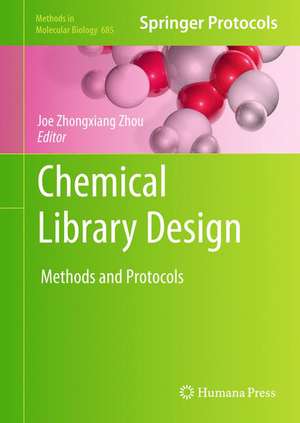Chemical Library Design: Methods in Molecular Biology, cartea 685
Editat de Joe Zhongxiang Zhouen Limba Engleză Hardback – 28 oct 2010
| Toate formatele și edițiile | Preț | Express |
|---|---|---|
| Paperback (1) | 705.18 lei 43-57 zile | |
| Humana Press Inc. – 23 aug 2016 | 705.18 lei 43-57 zile | |
| Hardback (1) | 959.19 lei 43-57 zile | |
| Humana Press Inc. – 28 oct 2010 | 959.19 lei 43-57 zile |
Din seria Methods in Molecular Biology
- 9%
 Preț: 791.59 lei
Preț: 791.59 lei - 23%
 Preț: 598.56 lei
Preț: 598.56 lei - 20%
 Preț: 882.95 lei
Preț: 882.95 lei -
 Preț: 252.04 lei
Preț: 252.04 lei - 5%
 Preț: 802.69 lei
Preț: 802.69 lei - 5%
 Preț: 729.61 lei
Preț: 729.61 lei - 5%
 Preț: 731.43 lei
Preț: 731.43 lei - 5%
 Preț: 741.30 lei
Preț: 741.30 lei - 5%
 Preț: 747.16 lei
Preț: 747.16 lei - 15%
 Preț: 663.45 lei
Preț: 663.45 lei - 18%
 Preț: 1025.34 lei
Preț: 1025.34 lei - 5%
 Preț: 734.57 lei
Preț: 734.57 lei - 18%
 Preț: 914.20 lei
Preț: 914.20 lei - 15%
 Preț: 664.61 lei
Preț: 664.61 lei - 15%
 Preț: 654.12 lei
Preț: 654.12 lei - 18%
 Preț: 1414.74 lei
Preț: 1414.74 lei - 5%
 Preț: 742.60 lei
Preț: 742.60 lei - 20%
 Preț: 821.63 lei
Preț: 821.63 lei - 18%
 Preț: 972.30 lei
Preț: 972.30 lei - 15%
 Preț: 660.49 lei
Preț: 660.49 lei - 5%
 Preț: 738.41 lei
Preț: 738.41 lei - 18%
 Preț: 984.92 lei
Preț: 984.92 lei - 5%
 Preț: 733.29 lei
Preț: 733.29 lei -
 Preț: 392.58 lei
Preț: 392.58 lei - 5%
 Preț: 746.26 lei
Preț: 746.26 lei - 18%
 Preț: 962.66 lei
Preț: 962.66 lei - 23%
 Preț: 860.21 lei
Preț: 860.21 lei - 15%
 Preț: 652.64 lei
Preț: 652.64 lei - 5%
 Preț: 1055.50 lei
Preț: 1055.50 lei - 23%
 Preț: 883.85 lei
Preț: 883.85 lei - 19%
 Preț: 491.88 lei
Preț: 491.88 lei - 5%
 Preț: 1038.84 lei
Preț: 1038.84 lei - 5%
 Preț: 524.15 lei
Preț: 524.15 lei - 18%
 Preț: 2122.34 lei
Preț: 2122.34 lei - 5%
 Preț: 1299.23 lei
Preț: 1299.23 lei - 5%
 Preț: 1339.10 lei
Preț: 1339.10 lei - 18%
 Preț: 1390.26 lei
Preț: 1390.26 lei - 18%
 Preț: 1395.63 lei
Preț: 1395.63 lei - 18%
 Preț: 1129.65 lei
Preț: 1129.65 lei - 18%
 Preț: 1408.26 lei
Preț: 1408.26 lei - 18%
 Preț: 1124.92 lei
Preț: 1124.92 lei - 18%
 Preț: 966.27 lei
Preț: 966.27 lei - 5%
 Preț: 1299.99 lei
Preț: 1299.99 lei - 5%
 Preț: 1108.51 lei
Preț: 1108.51 lei - 5%
 Preț: 983.72 lei
Preț: 983.72 lei - 5%
 Preț: 728.16 lei
Preț: 728.16 lei - 18%
 Preț: 1118.62 lei
Preț: 1118.62 lei - 18%
 Preț: 955.25 lei
Preț: 955.25 lei - 5%
 Preț: 1035.60 lei
Preț: 1035.60 lei - 18%
 Preț: 1400.35 lei
Preț: 1400.35 lei
Preț: 959.19 lei
Preț vechi: 1169.74 lei
-18% Nou
Puncte Express: 1439
Preț estimativ în valută:
183.54€ • 192.12$ • 152.76£
183.54€ • 192.12$ • 152.76£
Carte tipărită la comandă
Livrare economică 31 martie-14 aprilie
Preluare comenzi: 021 569.72.76
Specificații
ISBN-13: 9781607619307
ISBN-10: 160761930X
Pagini: 340
Ilustrații: X, 362 p.
Dimensiuni: 178 x 254 x 25 mm
Greutate: 0.84 kg
Ediția:2011
Editura: Humana Press Inc.
Colecția Humana
Seria Methods in Molecular Biology
Locul publicării:Totowa, NJ, United States
ISBN-10: 160761930X
Pagini: 340
Ilustrații: X, 362 p.
Dimensiuni: 178 x 254 x 25 mm
Greutate: 0.84 kg
Ediția:2011
Editura: Humana Press Inc.
Colecția Humana
Seria Methods in Molecular Biology
Locul publicării:Totowa, NJ, United States
Public țintă
ResearchCuprins
Historical Overview of Chemical Library Design.- Chemoinformatics and Library Design.- Molecular Library Design Using Multi-Objective Optimization Methods.- A Scalable Approach to Combinatorial Library Design.- Application of Free-Wilson Selectivity Analysis for Combinatorial Library Design.- Application of QSAR and Shape Pharmacophore Modeling Approaches for Targeted Chemical Library Design.- Combinatorial Library Design from Reagent Pharmacophore Fingerprints.- Docking Methods for Structure-Based Library Design.- Structure-Based Library Design in Efficient Discovery of Novel Inhibitors.- Structure-Based and Property-Compliant Library Design of 11-HSD1 Adamantyl Amide Inhibitors.- Design of Screening Collections for Successful Fragment-Based Lead Discovery.- Fragment-Based Drug Design.- LEAP into the Pfizer Global Virtual Library (PGVL) Space: Creation of Readily Synthesizable Design Ideas Automatically.- The Design, Annotation, and Application of a Kinase-Targeted-Library.- PGVL Hub: An Integrated Desktop Tool for Medicinal Chemists to Streamline Design and Synthesis of Chemical Libraries and Singleton Compounds.- Design of Targeted Libraries Against the Human Chk1 Kinase Using PGVL Hub.- GLARE: A Tool for Product-Oriented Design of Combinatorial Libraries.- CLEVER: A General Design Tool for Combinatorial Libraries.
Recenzii
From the reviews:
“This book contains 18 chapters divided into five sections. … great interest to investigators designing and synthesizing chemical libraries. … would be exceedingly useful to programmers or designers interested in developing combinatorial chemical library software utilities and, as such, will appeal to that audience. … very useful to a broad audience interested in chemical library design … . it is easy to read. … a valuable resource that should be educational and serve as a good resource for those interested in Chemical Library Design.” (David L. Roman, Journal of Medicinal Chemistry, Vol. 54 (12), 2011)
“This book contains 18 chapters divided into five sections. … great interest to investigators designing and synthesizing chemical libraries. … would be exceedingly useful to programmers or designers interested in developing combinatorial chemical library software utilities and, as such, will appeal to that audience. … very useful to a broad audience interested in chemical library design … . it is easy to read. … a valuable resource that should be educational and serve as a good resource for those interested in Chemical Library Design.” (David L. Roman, Journal of Medicinal Chemistry, Vol. 54 (12), 2011)
Textul de pe ultima copertă
Chemical library technologies have brought about dramatic changes in the drug discovery process, and, though still evolving, they have become an integral part of ongoing drug discovery research. In Chemical Library Design, experts in the field provide methods and detailed protocols delving into this key process of selecting useful, biologically relevant compounds from large pools of synthesizable candidates. This compendium includes chapters on historical overviews, state-of-the-art methodologies, including structure-based and fragment-based library design, practical software tools, and successful and important applications of chemical library design. As a volume in the popular Methods in Molecular Biology™ series, the thorough contributions provide the kind of meticulous description and implementation advice that is crucial for getting optimal results.Authoritative and cutting-edge, Chemical Library Design is an ideal reference for all scientists seeking the technology needed to aid in the search for new and vital drugs.
Caracteristici
Presents protocols with a design-based focus, from introductory overviews to detailed applications Provides contributions from expert practitioners featuring their tips for successful implementation of the techniques Includes sections on structure-based design, fragment-based design, design for kinase families, and key tools for design








